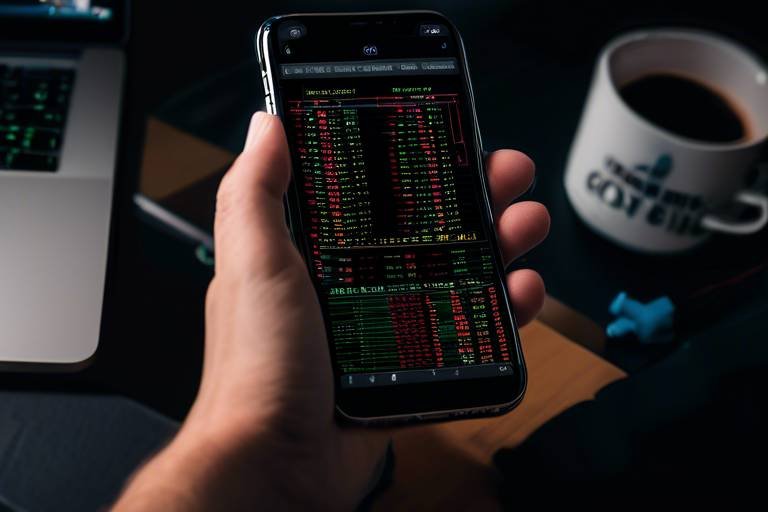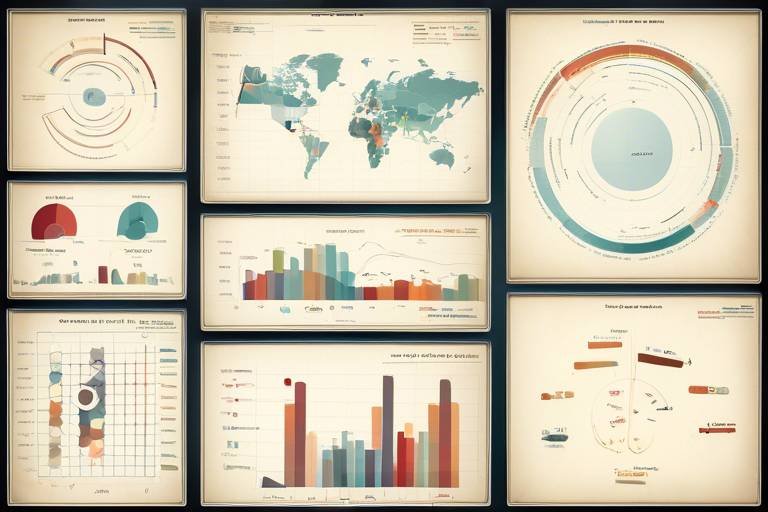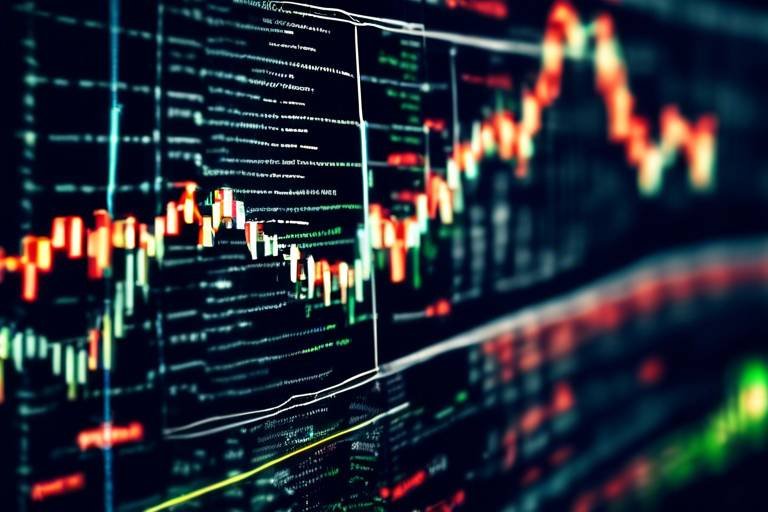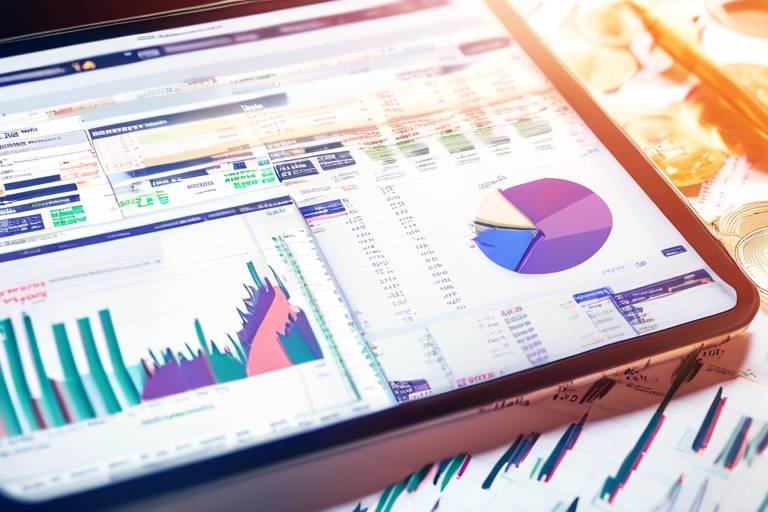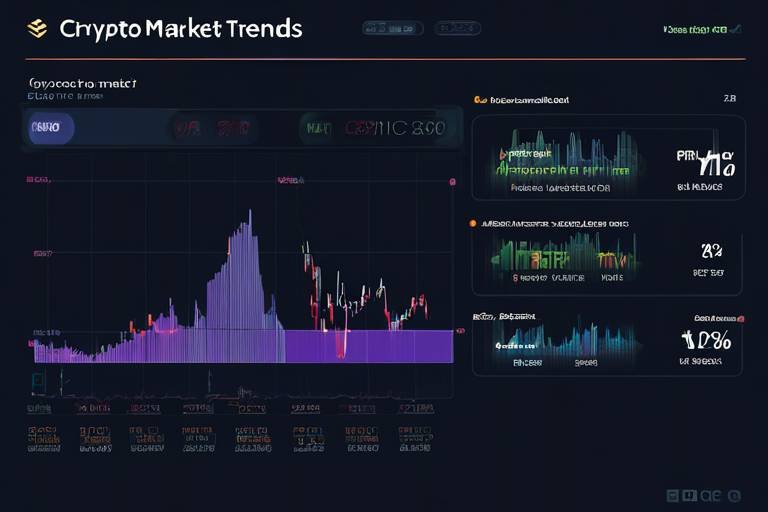Backtesting Strategies - Learning from Historical Data
In the world of trading, where every decision can lead to profit or loss, understanding the past is not just a luxury—it's a necessity. Backtesting strategies allow traders to dive deep into historical data, simulating how their trading strategies would have performed in various market conditions. Imagine being able to rewind time and test your strategies against real market movements. Wouldn’t that give you the confidence to trade more effectively? This article explores the significance of backtesting, detailing methods, best practices, and common pitfalls to enhance your understanding of historical data analysis for informed decision-making.
Backtesting is essentially a simulation of trading strategies using historical market data. By applying a trading strategy to past price movements, traders can evaluate its effectiveness and gauge how it would have performed under different market conditions. Think of it as a rehearsal before the big performance—by analyzing past outcomes, traders can gain insights that guide their future decisions. This process is crucial as it helps to identify whether a strategy is sound or if it needs tweaking before risking real capital in the market.
Understanding the importance of backtesting can significantly impact trading success. It’s not just about playing with numbers; it’s about gaining a deeper understanding of your strategies. Here’s why backtesting matters:
- Identify Weaknesses: Backtesting reveals potential flaws in your strategy, allowing you to make necessary adjustments.
- Confidence Building: Knowing how your strategy performed historically can boost your confidence when trading live.
- Risk Management: It helps in assessing the risk involved, enabling better decision-making.
By backtesting, traders can enter the market with a more informed perspective, reducing the chances of costly mistakes.
The backtesting process involves several steps. First, you need to define your trading strategy, including entry and exit points. Next, you apply this strategy to historical market data, calculating returns and analyzing performance metrics. This allows you to assess both risk and profitability. It’s like putting your strategy through a rigorous training camp, where it’s tested against various scenarios to see how it holds up. The results can reveal whether a strategy is robust enough to withstand the unpredictable nature of live trading.
Choosing the right historical data is crucial for accurate backtesting. Traders must consider factors such as:
- Data Quality: Ensure the data is clean and reliable.
- Timeframes: Select appropriate timeframes that reflect your trading style.
- Market Conditions: Consider the relevance of historical conditions to current markets.
Using high-quality data makes all the difference in achieving realistic backtest results. It’s like cooking with fresh ingredients; the outcome is always better!
Several software tools and platforms facilitate backtesting by providing historical data and simulation capabilities. Some popular tools include:
| Tool Name | Features |
|---|---|
| MetaTrader 4/5 | User-friendly interface, extensive historical data, and built-in strategy tester. |
| TradingView | Cloud-based, real-time data, and community-driven scripts for backtesting. |
| Amibroker | Powerful analysis tools and customizable backtesting scripts. |
Familiarity with these tools can enhance the backtesting process, making it easier to analyze and refine trading strategies.
Analyzing backtest results is essential for understanding a strategy's effectiveness. Traders must evaluate key performance indicators (KPIs) such as:
- Win Rates: The percentage of trades that were profitable.
- Drawdowns: The peak-to-trough decline during a trading period.
- Profit Factors: The ratio of gross profit to gross loss.
These metrics provide insights into the strategy's potential in live trading, helping traders make more informed decisions.
While backtesting is a valuable tool, it comes with its own set of limitations. Traders should be aware of issues like:
- Overfitting: When a strategy is too closely tailored to historical data, it may perform poorly in live markets.
- Data Snooping: Using the same data to optimize and test a strategy can lead to biased results.
- Past Performance: Just because a strategy worked in the past doesn’t guarantee future success.
Recognizing these limitations is crucial to developing robust trading strategies that can adapt to changing market conditions.
Overfitting occurs when a strategy is excessively adjusted to fit historical data, resulting in poor performance in real-world trading. It’s like trying to fit into a pair of shoes that are one size too small; it may seem perfect at first, but it becomes uncomfortable and impractical in the long run. Understanding this risk is vital for traders, as it encourages the development of strategies that are flexible and can withstand the unpredictable nature of the market.
Applying backtested strategies in real-world trading requires careful consideration. Traders must adapt their strategies to current market conditions while remaining mindful of the limitations observed during the backtesting phase. It’s not just about having a great strategy on paper; it’s about making it work in the dynamic and ever-changing world of trading. The key is to remain adaptable and open to tweaking your approach as new data comes in.
1. What is the best time frame for backtesting?
The best time frame depends on your trading style. Day traders might focus on minutes or hours, while swing traders may prefer daily or weekly charts.
2. Can backtesting guarantee future success?
No, backtesting cannot guarantee future results. It provides insights based on historical data but does not account for unforeseen market changes.
3. How do I avoid overfitting?
To avoid overfitting, ensure your strategy is not overly complex and test it on out-of-sample data to validate its effectiveness.
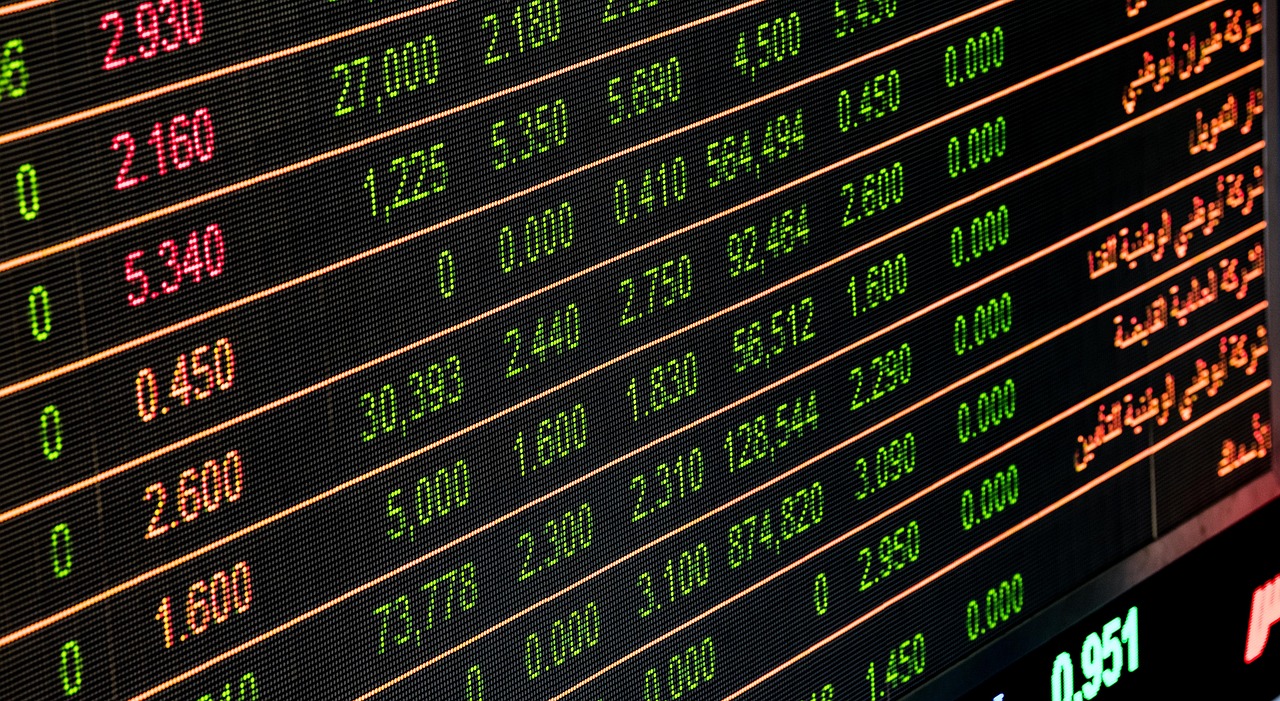
What is Backtesting?
This article explores the significance of backtesting in trading strategies, detailing methods, best practices, and common pitfalls to enhance your understanding of historical data analysis for informed decision-making.
Backtesting is an essential process in the world of trading, where traders evaluate the effectiveness of their strategies by applying them to historical data. Think of it as a time machine for your trading ideas; it allows you to see how a strategy would have performed in the past, which can be a game-changer when making future trading decisions. By analyzing past market conditions, traders can gain valuable insights into potential outcomes, helping them to refine their strategies before risking real capital.
To perform backtesting, traders typically follow a systematic approach. They start by selecting a trading strategy, which could range from simple moving averages to more complex algorithms. Next, they gather historical data that corresponds to the market conditions relevant to their strategy. This data might include price movements, volume, and other indicators that can influence trading performance. Once the data is in hand, traders apply their strategy to see how it would have fared during different market scenarios.
In essence, backtesting serves multiple purposes:
- Validation: It helps to confirm whether a trading strategy is viable based on historical performance.
- Optimization: Traders can tweak their strategies to enhance performance by identifying what worked and what didn't.
- Risk Assessment: It provides insights into potential risks associated with a strategy, allowing traders to make informed decisions about their capital allocation.
However, backtesting is not just about running numbers; it requires a deep understanding of market dynamics and the ability to interpret the results critically. For instance, a strategy might show a high return in backtesting but could be subject to extreme drawdowns that aren't evident from the historical data alone. Therefore, it’s crucial for traders to approach backtesting with a healthy dose of skepticism and to consider the broader market context when analyzing results.
In summary, backtesting is a powerful tool that can significantly enhance a trader's decision-making process. By simulating how strategies would have performed in the past, traders can make more informed choices in the present, reducing the risk of costly mistakes in live trading.
Understanding the importance of backtesting can significantly impact trading success. It allows traders to identify potential weaknesses in their strategies and make necessary adjustments before risking real capital in the market.
Backtesting involves applying a trading strategy to historical market data to determine its viability. This process includes defining entry and exit points, calculating returns, and analyzing performance metrics to assess risk and profitability.
Choosing the right historical data is crucial for accurate backtesting. Traders must consider data quality, timeframes, and the relevance of market conditions to ensure that the backtest results reflect realistic trading scenarios.
Several software tools and platforms facilitate backtesting by providing historical data and simulation capabilities. Familiarity with these tools can enhance the backtesting process, making it easier to analyze and refine trading strategies.
Analyzing backtest results is essential for understanding a strategy's effectiveness. Traders must evaluate key performance indicators, such as win rates, drawdowns, and profit factors, to gain insights into the strategy's potential in live trading.
While backtesting is a valuable tool, it has limitations. Traders should be aware of issues like overfitting, data snooping, and the assumption that past performance guarantees future results, which can lead to misguided decisions.
Overfitting occurs when a strategy is too closely tailored to historical data, resulting in poor performance in live markets. Recognizing this risk is vital to developing robust trading strategies that can adapt to changing market conditions.
Applying backtested strategies in real-world trading requires careful consideration. Traders must adapt their strategies to current market conditions while remaining mindful of the limitations observed during the backtesting phase.
Q: What is the main purpose of backtesting?
A: The main purpose of backtesting is to evaluate the effectiveness of a trading strategy using historical market data, allowing traders to refine their strategies before live trading.
Q: Can backtesting guarantee future profits?
A: No, backtesting cannot guarantee future profits as market conditions can change. It is a tool for analysis, not a crystal ball.
Q: How can I avoid overfitting in my strategy?
A: To avoid overfitting, ensure that your strategy is robust and generalizable by testing it on different data sets and avoiding excessive complexity.
Q: What are some common backtesting tools?
A: Some common backtesting tools include MetaTrader, TradingView, and specialized software like Amibroker or NinjaTrader.

Importance of Backtesting
Understanding the can significantly impact trading success. Imagine you're about to embark on a long journey across uncharted waters; wouldn't you want to consult a map that details every twist and turn? That's essentially what backtesting does for traders. It serves as a roadmap, guiding them through the complexities of the market by revealing how a particular trading strategy would have performed in the past.
One of the primary benefits of backtesting is its ability to highlight potential weaknesses in a trading strategy. By analyzing historical data, traders can identify patterns and outcomes that might not be apparent at first glance. This insight allows for necessary adjustments before risking real capital in the market. For instance, if a strategy shows a high win rate but also significant drawdowns during specific market conditions, adjustments can be made to mitigate those risks.
Moreover, backtesting provides a sense of confidence. It's like a rehearsal before the big performance. When traders see how their strategies would have fared in various market conditions, they can trade with a greater sense of assurance. This confidence can be crucial, especially in volatile markets where emotions often run high. A well-tested strategy can help keep panic at bay, allowing traders to stick to their plans even when the market gets choppy.
Additionally, backtesting enables traders to develop a more robust understanding of market dynamics. By simulating trades over different timeframes and conditions, traders can gain insights into how external factors—like economic news or geopolitical events—affect their strategies. For example, a trader might notice that their strategy performs exceptionally well during bullish trends but falters in bearish ones. This knowledge can lead to more informed decision-making in real-time trading scenarios.
However, it's essential to approach backtesting with a critical eye. While it can provide valuable insights, it should not be the sole basis for trading decisions. Traders must continuously adapt their strategies to the ever-changing market landscape. In summary, backtesting is not just a tool; it's a foundational element of a successful trading strategy that helps traders navigate through uncertainty with clarity and confidence.
- What is backtesting? Backtesting is the process of testing a trading strategy on historical data to evaluate its effectiveness.
- Why is backtesting important? It helps traders identify weaknesses in their strategies, build confidence, and understand market dynamics.
- Can backtesting guarantee future success? No, while backtesting provides insights, it does not guarantee future performance due to the ever-changing nature of the markets.
- What are common pitfalls of backtesting? Common pitfalls include overfitting, data snooping, and assuming that past performance will predict future results.

How Backtesting Works
Backtesting is an essential component of developing a successful trading strategy, and understanding how it works can make all the difference in your trading journey. The process begins by defining your trading strategy, which includes establishing clear entry and exit points based on specific criteria. For instance, you might decide to enter a trade when a stock's price crosses above its 50-day moving average and exit when it falls below that threshold. This clarity is crucial because it sets the rules for your backtest.
Once your strategy is defined, the next step involves applying it to historical market data. This is where the magic happens! You take a dataset that includes price movements, volume, and other relevant indicators, and you simulate trades as if you had been trading in real-time. This simulation allows you to see how your strategy would have performed under various market conditions. The beauty of this process lies in its ability to reveal insights that might not be apparent just by looking at the data.
To effectively analyze the performance of your strategy, you need to calculate key performance metrics. These metrics often include:
- Win Rate: The percentage of trades that were profitable.
- Drawdown: The maximum observed loss from a peak to a trough.
- Profit Factor: The ratio of gross profit to gross loss.
By evaluating these metrics, you can gain a clearer picture of how robust your strategy is. For instance, a high win rate might sound great, but if the drawdown is substantial, it could indicate that the strategy is not sustainable in the long run.
Moreover, it’s essential to consider the timeframes you’re analyzing. Different strategies may perform well on daily charts but poorly on hourly charts, or vice versa. Therefore, backtesting across multiple timeframes can help you identify the most suitable one for your approach. This step is akin to trying on different outfits before a big event; you want to find what fits best!
Finally, after running your backtest, it's crucial to interpret the results correctly. You might be tempted to jump into live trading immediately, but taking the time to analyze what the data is telling you can save you from costly mistakes. Look for patterns, anomalies, and areas where the strategy can be improved. Remember, backtesting is not just about confirming your beliefs; it's about challenging them and refining your approach based on data.
In summary, backtesting works by applying a well-defined trading strategy to historical data, calculating key performance metrics, and interpreting the results to enhance future trading decisions. It’s a powerful tool that, when used correctly, can significantly improve your trading success.
- What is the best data source for backtesting? - The best data source varies by strategy, but reputable financial data providers offer comprehensive historical datasets.
- How long should I backtest a strategy? - Generally, backtesting over multiple years of data can provide a more reliable assessment of a strategy's effectiveness.
- Can backtesting guarantee future success? - No, while backtesting can identify potential strengths and weaknesses, it cannot guarantee future performance due to market unpredictability.

Data Selection for Backtesting
When it comes to backtesting, the data you choose can make or break your results. Think of it like a chef selecting ingredients for a recipe; the quality and type of ingredients will determine the final dish's flavor. In the same way, the right historical data is essential for accurate backtesting. You want to ensure that the data reflects the market conditions that are relevant to your strategy. Here are some key factors to consider when selecting data:
- Data Quality: High-quality data is crucial. Poor data can lead to misleading results. Always opt for data that is clean, well-structured, and free from errors.
- Timeframes: The timeframe of your data matters. Are you testing a day trading strategy or a long-term investment approach? Make sure the historical data matches your strategy's timeframe.
- Market Conditions: Consider the market environment during the period you are analyzing. Was it a bull market, bear market, or sideways? The relevance of these conditions can significantly impact your strategy's effectiveness.
Additionally, it’s essential to include a diverse range of market scenarios in your dataset. This means not just cherry-picking periods of success but also incorporating downturns and periods of high volatility. By doing so, you can better understand how your strategy might perform in different situations.
Another important aspect is the frequency of the data. For example, if you’re backtesting a strategy that trades on a minute-by-minute basis, you’ll need minute-level data. On the other hand, if your strategy is based on daily or weekly trends, then daily or weekly data will suffice. The granularity of your data should align with the strategy being tested.
Lastly, don’t forget about the importance of adjusting for corporate actions such as stock splits, dividends, and mergers. These factors can distort historical price data and lead to inaccurate backtest results. Ensuring that your data is adjusted for these events will provide a more realistic picture of how your strategy would have performed.
In summary, selecting the right data for backtesting is a meticulous process that requires careful consideration. By focusing on data quality, timeframe relevance, market conditions, frequency, and corporate actions, you can enhance the reliability of your backtest results and make more informed trading decisions.
Q: What is the best data source for backtesting?
A: The best data source depends on your trading strategy. Some popular data sources include financial data providers, brokerage platforms, and specialized backtesting software that offer historical data tailored to your needs.
Q: How much historical data do I need for backtesting?
A: Generally, the more data, the better. However, the amount of historical data required can vary based on your trading strategy. For short-term strategies, a few months may suffice, while long-term strategies may need several years of data.
Q: Can I use free data for backtesting?
A: Yes, there are various free data sources available, but be cautious about their quality and accuracy. Always validate the data before relying on it for backtesting.

Common Backtesting Tools
When it comes to backtesting trading strategies, having the right tools at your disposal can make all the difference. Just like a chef needs quality knives to create a masterpiece, traders require robust software to analyze historical data effectively. There are several popular backtesting tools available that cater to different levels of expertise and trading styles. These tools not only provide historical data but also offer simulation capabilities to test strategies under various market conditions.
Some of the most widely used backtesting tools include:
- MetaTrader 4/5: This is perhaps the most popular platform among retail traders. With built-in backtesting features, it allows users to test their trading strategies against historical data easily. The user-friendly interface and extensive community support make it an excellent choice for beginners.
- TradingView: Known for its powerful charting capabilities, TradingView also offers backtesting features through its Pine Script programming language. This tool is perfect for traders who want to create custom indicators and backtest them visually.
- QuantConnect: For those looking to dive deeper into algorithmic trading, QuantConnect offers a cloud-based platform that supports multiple programming languages. It allows you to backtest strategies against a vast array of historical data, making it a favorite among quantitative traders.
- Amibroker: This is a comprehensive analysis and backtesting software that provides advanced features for traders who want to perform in-depth statistical analysis. Its flexibility and powerful scripting language make it suitable for more experienced traders.
Using these tools can significantly enhance your backtesting process. However, it’s essential to choose one that aligns with your trading style and technical proficiency. Each tool has its unique strengths, and understanding these can help you make informed decisions about which one to use.
Before diving into backtesting, take the time to familiarize yourself with the tool of your choice. Most platforms offer tutorials and community forums that can help you get started. Remember, the goal is to refine your trading strategies based on historical performance, so leveraging the right tools is crucial for success.
- What is backtesting? Backtesting is the process of testing a trading strategy using historical market data to evaluate its effectiveness and potential profitability.
- Why is backtesting important? It helps traders identify weaknesses in their strategies, allowing for necessary adjustments before risking real capital.
- What tools can I use for backtesting? Popular tools include MetaTrader, TradingView, QuantConnect, and Amibroker, each offering unique features for different trading styles.
- What are common pitfalls in backtesting? Traders should be cautious of overfitting, data snooping, and assuming that past performance guarantees future results.

Interpreting Backtest Results
When it comes to trading, the results of your backtest can feel like a treasure map leading you to potential success. However, interpreting these results is akin to deciphering a complex code; it requires careful examination and understanding of various performance indicators. Key performance metrics play a vital role in this process, enabling traders to gauge the effectiveness of their strategies. Let's dive into some of the most important metrics you should focus on:
| Performance Metric | Description |
|---|---|
| Win Rate | The percentage of trades that were profitable compared to the total number of trades executed. |
| Drawdown | The maximum observed loss from a peak to a trough during the backtesting period. |
| Profit Factor | The ratio of gross profit to gross loss, indicating how much profit is made for each dollar lost. |
| Sharpe Ratio | A measure of risk-adjusted return, indicating how much excess return you receive for the extra volatility endured. |
Understanding these metrics is essential because they provide insights into the potential performance of your strategy in live trading. For example, a high win rate might seem appealing at first glance, but if it comes with a significant drawdown, it could signal a risky strategy that might not withstand market fluctuations. Conversely, a lower win rate with a high profit factor could indicate a strategy that, while not winning every trade, has the potential to be more profitable over time.
Moreover, the Sharpe Ratio is particularly useful for comparing different strategies. A higher Sharpe ratio indicates that the strategy is providing a better return for the risk taken, which can be a game-changer in your trading decisions. Thus, when interpreting backtest results, you should take a holistic approach, looking at how these metrics interact with one another rather than isolating them.
In addition to these metrics, it’s crucial to consider the market conditions during the backtest. A strategy that performs well in a trending market might falter in a sideways market, and vice versa. Therefore, you should always ask yourself: Does the historical data reflect the current market environment? This question is key to ensuring that your backtested results are relevant and actionable.
Lastly, don’t forget to document your findings and insights from the backtest. Keeping a record not only helps you refine your strategy but also assists in building a knowledge base that can be invaluable for future trading endeavors. Remember, the goal of backtesting is not just to validate a strategy but to learn from it and adapt as necessary.
- What is backtesting? Backtesting is the process of testing a trading strategy using historical data to see how it would have performed.
- Why is backtesting important? It helps traders identify weaknesses in their strategies and make necessary adjustments before risking real money.
- What metrics should I focus on when interpreting backtest results? Key metrics include win rate, drawdown, profit factor, and Sharpe ratio.
- Can backtesting guarantee future success? No, past performance does not guarantee future results, but it can provide valuable insights.
- How can I improve my backtesting process? Use high-quality data, avoid overfitting, and continuously document and analyze your results.

Limitations of Backtesting
While backtesting is a powerful tool in a trader's arsenal, it is essential to recognize its limitations. One of the primary issues is the risk of overfitting. This occurs when a trading strategy is excessively tailored to historical data, making it perform exceptionally well in backtests but poorly in real-world scenarios. Think of it as trying to fit a square peg into a round hole; just because it works in theory doesn't mean it will work in practice. Overfitting can create a false sense of security, leading traders to believe they have found the perfect strategy when, in reality, it may not be adaptable to changing market conditions.
Another significant limitation is data snooping, which refers to the practice of testing multiple strategies on the same dataset until a profitable one is discovered. This can result in a strategy that appears successful simply due to random chance rather than genuine effectiveness. It's akin to searching for a needle in a haystack; if you poke around enough, you might eventually find something that looks good, but it doesn't mean it will hold up under scrutiny.
Moreover, traders often fall into the trap of believing that past performance guarantees future results. This assumption can lead to misguided decisions, as market conditions are constantly evolving. For example, a strategy that worked well during a bull market may falter during a bear market. Therefore, it is imperative for traders to remain vigilant and adaptable, continuously refining their strategies based on current market dynamics rather than relying solely on historical data.
Lastly, the quality of historical data is paramount. Using poor quality data can skew backtesting results, leading to inaccurate conclusions. Traders should ensure they are using reliable, high-quality data that accurately reflects the market conditions they wish to analyze. A table summarizing the key limitations of backtesting is provided below for quick reference:
| Limitation | Description |
|---|---|
| Overfitting | Strategies too closely tailored to historical data, leading to poor live performance. |
| Data Snooping | Testing multiple strategies on the same dataset can yield misleading results. |
| Past Performance | Assuming that past results will predict future success can be dangerous. |
| Data Quality | Poor quality historical data can lead to inaccurate backtesting conclusions. |
In conclusion, while backtesting can provide invaluable insights into the potential effectiveness of trading strategies, it is crucial to approach it with a healthy dose of skepticism. By being aware of its limitations and continuously adapting strategies to current market conditions, traders can enhance their chances of success in the ever-changing landscape of financial markets.
What is backtesting?
Backtesting is the process of testing trading strategies against historical data to evaluate their effectiveness.
Why is backtesting important?
Backtesting helps traders identify potential weaknesses in their strategies and make adjustments before risking real capital.
What are the common pitfalls of backtesting?
Common pitfalls include overfitting, data snooping, assuming past performance guarantees future results, and using poor quality data.
How can I avoid overfitting?
To avoid overfitting, ensure your strategy is robust and can adapt to changing market conditions rather than being overly tailored to historical data.

Overfitting in Backtesting
When diving into the world of backtesting, one of the most critical concepts to grasp is overfitting. Think of it as a double-edged sword; while backtesting can provide invaluable insights into the viability of a trading strategy, overfitting can lead traders down a perilous path. So, what exactly is overfitting? In simple terms, it occurs when a trading strategy is excessively tailored to historical data. This means that the strategy has been adjusted so finely to fit past market movements that it loses its effectiveness in real-world trading scenarios.
Imagine a tailor crafting a suit. If the tailor focuses solely on the measurements of one individual, the suit may fit perfectly on that person but be completely unwearable for anyone else. Similarly, a strategy that performs exceptionally well on historical data may completely flop when faced with the unpredictable nature of live markets. This phenomenon can create a false sense of security, leading traders to believe they have a foolproof strategy when, in reality, it is merely a mirage created by the specific conditions of the past.
To illustrate the concept further, let’s consider a few common signs of overfitting:
- High Complexity: Strategies that incorporate numerous indicators or parameters can often lead to overfitting. The more complex a strategy, the more likely it is to be tailored to past data.
- Unrealistic Performance Metrics: If a strategy shows extraordinarily high returns with minimal drawdown during backtesting, it’s essential to scrutinize the results. Such performance is often too good to be true.
- Poor Out-of-Sample Performance: If a strategy performs well on historical data but fails to deliver similar results in a different time frame or market condition, it’s a clear indication of overfitting.
To combat overfitting, traders can employ several strategies:
- Simplify Your Strategy: Aim for simplicity. A straightforward strategy is often more adaptable to changing market conditions.
- Use Cross-Validation: This technique involves testing the strategy on different subsets of data to ensure its robustness.
- Focus on Economic Principles: Ensure that your strategy is grounded in sound economic theory rather than being solely a product of historical data.
In conclusion, while backtesting is a powerful tool, it’s crucial to remain vigilant about the risks of overfitting. By understanding and recognizing the signs, traders can develop more resilient strategies that stand the test of time, rather than ones that merely excel in hindsight. Remember, the goal is not just to create a strategy that performs well on paper but one that can adapt and thrive in the ever-changing landscape of the financial markets.
- What is overfitting in trading strategies? Overfitting occurs when a trading strategy is too closely aligned with historical data, resulting in poor performance in real-world trading conditions.
- How can I avoid overfitting? To avoid overfitting, focus on simplifying your strategy, using cross-validation techniques, and grounding your strategy in economic principles.
- Why is backtesting important? Backtesting allows traders to evaluate the effectiveness of their strategies using historical data, helping them make informed decisions before risking real capital.

Real-World Application of Backtesting
When it comes to the , it’s crucial to understand that the journey doesn’t end with analyzing historical data. Instead, it’s just the beginning of a new chapter in your trading saga. Think of backtesting as a rehearsal for a grand performance; you can practice all you want, but when it’s time to hit the stage, the real magic happens. So, how do you transition from backtesting to actual trading?
First and foremost, it’s essential to adapt your strategies based on current market conditions. Markets are dynamic, and what worked in the past may not necessarily work in the future. A strategy that showed promise in a bullish market may falter in a bearish environment. Therefore, always keep an eye on economic indicators, news events, and market sentiment. This adaptability is akin to a skilled chef who adjusts a recipe based on the season’s freshest ingredients.
Moreover, implementing a backtested strategy requires a solid understanding of risk management. Just because a strategy performed well historically doesn’t mean it’s foolproof. Traders should establish stop-loss orders and position sizing rules to protect their capital. This approach not only mitigates risk but also allows traders to stay in the game longer. Imagine you’re a tightrope walker; one misstep could lead to a fall, but with a safety net in place, you can focus on your performance without fear.
Another vital aspect is to maintain a trading journal. Documenting your trades, including the rationale behind each decision, can provide invaluable insights over time. It’s like keeping a diary of your journey; you’ll be able to reflect on what worked, what didn’t, and why. Consistency in this practice can lead to improved decision-making and greater emotional control, which are critical in the often volatile world of trading.
Lastly, remember that backtesting is not a one-time event. It’s an ongoing process. As you trade, continually revisit and refine your strategies based on new data and experiences. This iterative approach ensures that your trading strategies evolve alongside the market, keeping you relevant and competitive.
- What is the main purpose of backtesting?
Backtesting allows traders to evaluate how a trading strategy would have performed in the past using historical data, helping them make informed decisions for future trades. - Can backtesting guarantee future success?
No, while backtesting can provide valuable insights, it cannot guarantee that a strategy will perform the same way in the future due to changing market conditions. - What are some common pitfalls in backtesting?
Common pitfalls include overfitting, data snooping, and misunderstanding the limitations of historical data, which can lead to misguided trading decisions. - How can I improve my backtesting process?
Improving your backtesting process involves using high-quality data, refining your strategies based on results, and continuously adapting to current market conditions.
Frequently Asked Questions
- What is the primary purpose of backtesting?
The primary purpose of backtesting is to evaluate the effectiveness of trading strategies using historical data. By simulating how a strategy would have performed in the past, traders can gain insights that guide their future trading decisions, helping them to minimize risks and maximize potential profits.
- How do I select the right historical data for backtesting?
Selecting the right historical data is crucial for accurate backtesting. Traders should focus on data quality, ensuring it is clean and relevant. Additionally, considering the timeframe and market conditions during the period being tested is essential to ensure the results are reflective of realistic trading scenarios.
- What are some common pitfalls in backtesting?
Some common pitfalls in backtesting include overfitting, where a strategy is too closely tailored to past data, resulting in poor performance in live markets. Other issues include data snooping, which can lead to misleading results, and the misconception that past performance guarantees future results, which can misguide traders.
- What tools can I use for backtesting?
There are several software tools and platforms available for backtesting, including MetaTrader, TradingView, and specialized backtesting software like Amibroker. Familiarity with these tools can significantly enhance the backtesting process, allowing traders to efficiently analyze and refine their strategies.
- How can I interpret backtest results effectively?
Interpreting backtest results involves evaluating key performance indicators such as win rates, drawdowns, and profit factors. By analyzing these metrics, traders can understand a strategy's potential effectiveness in live trading and make informed decisions about adjustments or implementations.
- Can I rely solely on backtesting for trading decisions?
While backtesting is a valuable tool, it should not be the sole basis for trading decisions. Traders must consider current market conditions, adapt their strategies accordingly, and remain aware of the limitations observed during backtesting to avoid potential pitfalls in live trading.




